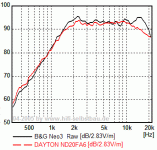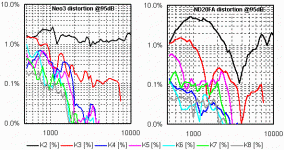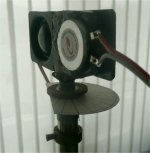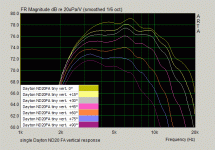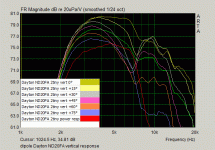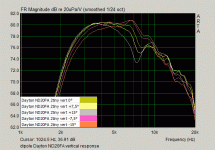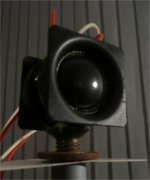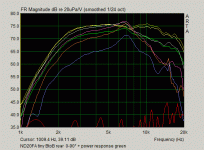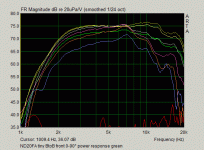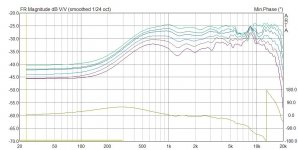... but how much of the already minimal power handling and low frequency extension will remain after EQ to even make it to a 3k crossover?
I can't tell you, I can only compare - see diagrams. All measurements are for the closed version of the Neo3 PDR and in infinite baffle. Identical measuring conditions for both drivers, but not done by me.
To put things straight: I'm not advocating to replace all Neo3s by tiny Daytons. I was only trying to find the limit, where dome tweeters can work as true dipoles.
Attachments
does anyone know of a motorola source in the UK
does anyone know of a motorola piezo tweeter source in the UK?
If you remember those 2" piezo cones they did, may youd know where to source them?
Im thinking i might try rudolfs dipole experiment with a pair of those piezos.....
does anyone know of a motorola piezo tweeter source in the UK?
If you remember those 2" piezo cones they did, may youd know where to source them?
Im thinking i might try rudolfs dipole experiment with a pair of those piezos.....
Great thread. This have given me the motivation to test some ridiculously small dome tweeters that I have in a back to back configuration for dipole directivity.
It's the super tweeter shown here, but without the full aluminium housing.
It's the super tweeter shown here, but without the full aluminium housing.
An externally hosted image should be here but it was not working when we last tested it.
I can't tell you, I can only compare - see diagrams. All measurements are for the closed version of the Neo3 PDR and in infinite baffle. Identical measuring conditions for both drivers, but not done by me.
To put things straight: I'm not advocating to replace all Neo3s by tiny Daytons. I was only trying to find the limit, where dome tweeters can work as true dipoles.
I'm a little confused - is the dual Dayton configuration you've assembled a "true dipole" or "true bipole"? What impact will this configuration have on the "figure 8" pattern true dipoles are known for? Not sure that it really matters.....maybe it's important to some OB purists - I'm kinda green with these dipole and bipole concepts.......
I'm a little confused - is the dual Dayton configuration you've assembled a "true dipole" or "true bipole"? What impact will this configuration have on the "figure 8" pattern true dipoles are known for? Not sure that it really matters.....maybe it's important to some OB purists - I'm kinda green with these dipole and bipole concepts.......
Bipole: front/rear drivers are operated in phase
Dipole: front/rear drivers are operated in anti-phase
Both are very interesting concepts.
Implemented correctly, a dipole will provide a figure eight response at the expense of displacement.
I have not seen much interest in bipoles. However, they may offer the opportunity for a minimum of diffraction.
As far as I understand, diffraction is a result of pressure gradients. The sound wave diffracts around the enclosure in order to equalize the pressure gradient. If both drivers are operated in phase, a pressure gradient may not be present. Assuming optimal conditions, the sound waves will support each other and a virtual "infinite baffle" may be created.
Just some thoughts.
Best Regards,
Thadman
You're understanding seems to mirror mine. It was not very clear to me exactly what Rudy was producing with the two Daytons - if they were wired out of phase, without some other manipulation of the signal, the apparent phase shift from voice coil centers in different locations would seem to create a response that is other than a "true dipole" - my concept of a "true dipole" is something akin to a single diaphragm or driver radiating in both directions - like most electrostatics. I guess the terminology is more fluid than I thought.Bipole: front/rear drivers are operated in phase
Dipole: front/rear drivers are operated in anti-phase
Both are very interesting concepts.
Implemented correctly, a dipole will provide a figure eight response at the expense of displacement.
I have not seen much interest in bipoles. However, they may offer the opportunity for a minimum of diffraction.
As far as I understand, diffraction is a result of pressure gradients. The sound wave diffracts around the enclosure in order to equalize the pressure gradient. If both drivers are operated in phase, a pressure gradient may not be present. Assuming optimal conditions, the sound waves will support each other and a virtual "infinite baffle" may be created.
Just some thoughts.
Best Regards,
Thadman
... is the dual Dayton configuration you've assembled a "true dipole" or "true bipole"? What impact will this configuration have on the "figure 8" pattern true dipoles are known for? Not sure that it really matters.....maybe it's important to some OB purists ...
villastrangiato,
all my configurations are "figure 8" dipoles. But can you imagine a "slim" 8 and a "fat" eight? Many dipoles change their 8 between slim and fat (and vice versa) along their frequency range. Only dipoles, which don't change the proportion of their 8 with frequency, are called "constant directivity" (CD) dipoles.
The purpose of this thread is to discuss the conditions for a true CD dipole tweeter. You could call that an "OB purist thing", yes.
Rudolf
... one might try to do a dipole ring of that cheap tweeters around the middle dipole ....
That'll be an 'inside out' coaxial !
Immediate desaster
Today I measured the vertical response of my tiny dipole tweeter. In fact I turned the baffle 90° and rotated it horizontally:
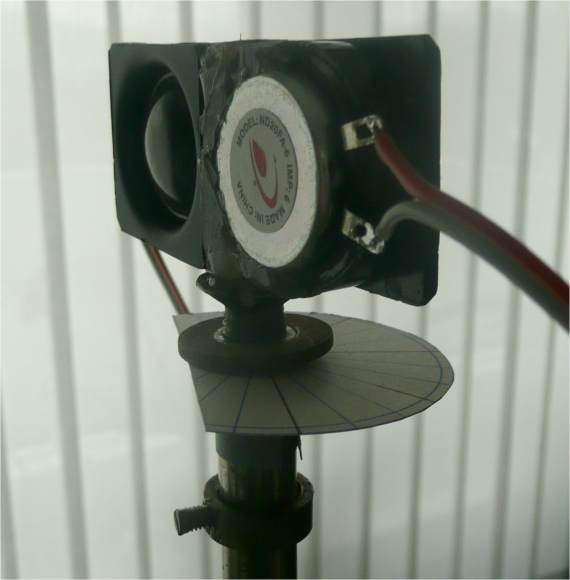
Results were much worse than I had expected. First "upward":
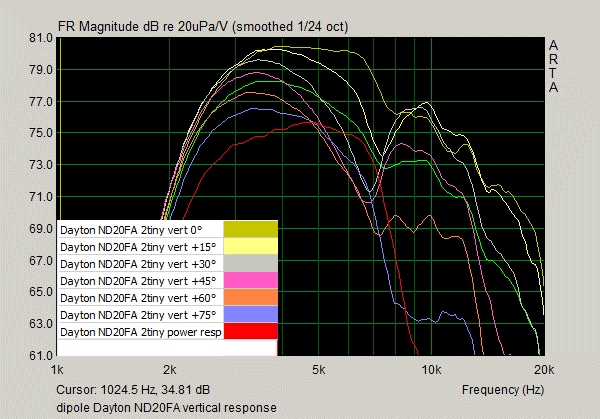
Then in smaller steps around 0°:
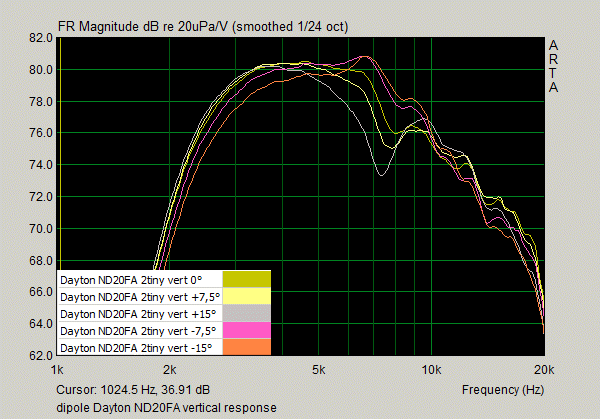
Things get out of control almost immediately. Even +/- 7.5 deg is not bearable. So back to the drawing board. It will take me some time to get the sticky gum away from the tweeters.
Afterwards I will again try the tweeters back-to-back and see, whether cutting away some of the baffle area has done anything helpful to that configuration.
Rudolf
Today I measured the vertical response of my tiny dipole tweeter. In fact I turned the baffle 90° and rotated it horizontally:
Results were much worse than I had expected. First "upward":
Then in smaller steps around 0°:
Things get out of control almost immediately. Even +/- 7.5 deg is not bearable. So back to the drawing board. It will take me some time to get the sticky gum away from the tweeters.
Afterwards I will again try the tweeters back-to-back and see, whether cutting away some of the baffle area has done anything helpful to that configuration.
Rudolf
Attachments
This will be the last time ...
I glued the poor tiny Daytons together back to back and got a package of 3.3 x 3.3 x 3.0 cm:

The resulting dipole response is possibly the best one can get with these tweeters without compromising any direction (as in my last attempt ):
):
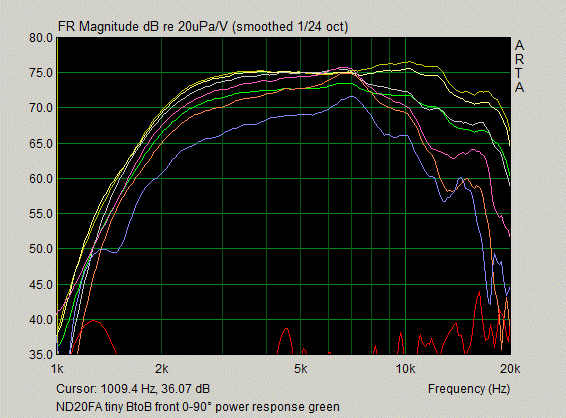
But there is a back side to everything - literally. The quality control of those cheap ND20FA isn't very picky - resulting in a less convincing response from the opposite driver:
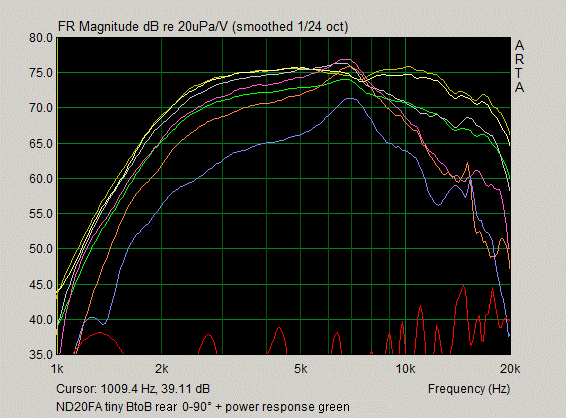
For comparison I show the response of the original unequalised ND20FA dipole in a small housing as presented in post #6:
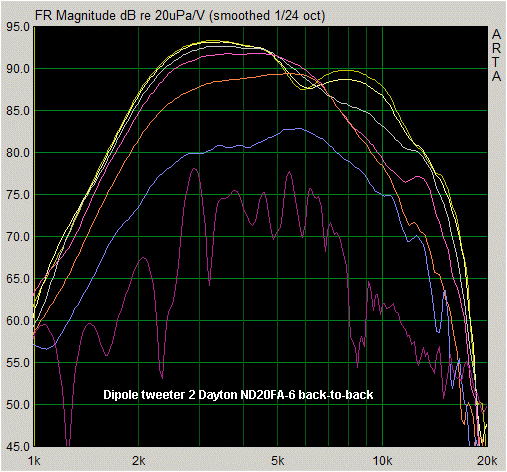
Can you spot the progress?

I now will take the Dayton tweeter dipoles and put them in place of the larger Monacor dipoles. If they sound better, they will stay. If not ... I don´t believe they would sell on the bay in this shape.
Rudolf
I glued the poor tiny Daytons together back to back and got a package of 3.3 x 3.3 x 3.0 cm:
The resulting dipole response is possibly the best one can get with these tweeters without compromising any direction (as in my last attempt
But there is a back side to everything - literally. The quality control of those cheap ND20FA isn't very picky - resulting in a less convincing response from the opposite driver:
For comparison I show the response of the original unequalised ND20FA dipole in a small housing as presented in post #6:

Can you spot the progress?
I now will take the Dayton tweeter dipoles and put them in place of the larger Monacor dipoles. If they sound better, they will stay. If not ... I don´t believe they would sell on the bay in this shape.
Rudolf
Attachments
What about a special dipole-tweeter that uses one voicecoil for a backside and a frontside tweeter. That should be small and thin enough to work perfectly up to highest frequency. The problem is you can't use pole pieces in this configuration, but two rings of NdFeB should to pretty good as well
Here's a sketch (voicecoil is 25mm):
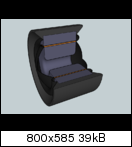
On the pro-side:
- low fs due to "infinite" volume inside the tweeter
- wisely planned magnetics could result in a large xmax and low variances in Bl(x)
- two surrounds lead to less rocking motions and due to the symmetrically placed surrounds, linearity in suspension should increase and variances in Kms(x) should decrease
- all this results in a better behaviour at lower frequencies
And now all that as a one inch tweeter with large surround and as a three inch dome midrange, that would be nice...
Bye,
Spatz
@ Rudolf:
How dare you not publishing these results in German boards!

Here's a sketch (voicecoil is 25mm):

On the pro-side:
- low fs due to "infinite" volume inside the tweeter
- wisely planned magnetics could result in a large xmax and low variances in Bl(x)
- two surrounds lead to less rocking motions and due to the symmetrically placed surrounds, linearity in suspension should increase and variances in Kms(x) should decrease
- all this results in a better behaviour at lower frequencies
And now all that as a one inch tweeter with large surround and as a three inch dome midrange, that would be nice...
Bye,
Spatz
@ Rudolf:
How dare you not publishing these results in German boards!

I'm getting (what I think are) decent results with my Neo3 PDRW. The trick seems to be the amount of effort I put into fixing the on-axis null - too much and too little both seem to hurt the overall response. I'm still experimenting - here's my last attempt, 1800 LR4 XO to a 6.5" midrange, no foam or felt on the tweeter:
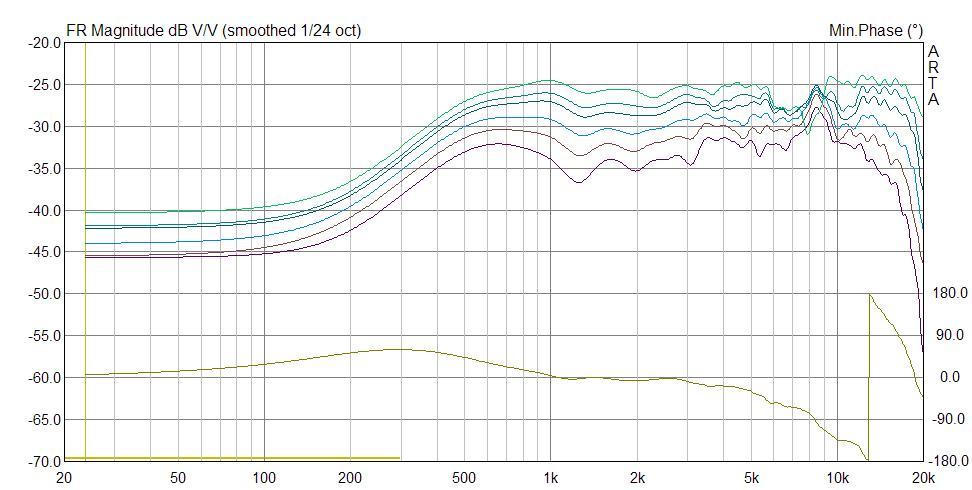
The listening axis is around the 2nd or 3rd curve from the top. I plan to try a notch for that 9kHz peak, even though it'll make the on-axis response worse. It's funny how a totally different picture emerges when you look at the off-axis plots.
I agree with keyser that the non-PDR model would probably be a better choice. Well, different set of trade-offs, I guess.
The listening axis is around the 2nd or 3rd curve from the top. I plan to try a notch for that 9kHz peak, even though it'll make the on-axis response worse. It's funny how a totally different picture emerges when you look at the off-axis plots.
I agree with keyser that the non-PDR model would probably be a better choice. Well, different set of trade-offs, I guess.
Attachments
Spatz,
if your design is technically feasable - which I can't judge - it would surely help to make a very compact dipole tweeter. But I don't know, if there is a market for more than two dozen pairs worldwide.
Saurav,
- adding nothing around the tweeter that could increase the dipole length
- ignoring the 0° axis when equalizing
- listenig off axis at 15-30°
those could be the best strategies when dealing with dipole tweeters. And yes, getting those small critical areas in the response right can become a never ending story ...
Rudolf
if your design is technically feasable - which I can't judge - it would surely help to make a very compact dipole tweeter. But I don't know, if there is a market for more than two dozen pairs worldwide.
Saurav,
- adding nothing around the tweeter that could increase the dipole length
- ignoring the 0° axis when equalizing
- listenig off axis at 15-30°
those could be the best strategies when dealing with dipole tweeters. And yes, getting those small critical areas in the response right can become a never ending story ...
Rudolf
Hi Rudolf,
this design is feasible, but you need radially magnetized neodym-rings. Aurasound can do that, I dn't know who else...
Of course, these tweeters could be used in other setups as well: for example, you could put it into baffle an place a highly damped box behind it. Now you have a normal tweeter with good motor and large chamber.
Or you could place it in front of a box that is open on the front and place some damping in the box keeping some distance to the driver (5-10 cm). Thus, the directivity to the front should be perfect, but on the rearside of the box there shouldn't be any sound...
You see, this product would be quite versatile, so there should be a market for those tweeters...
Bye, Spatz
this design is feasible, but you need radially magnetized neodym-rings. Aurasound can do that, I dn't know who else...
Of course, these tweeters could be used in other setups as well: for example, you could put it into baffle an place a highly damped box behind it. Now you have a normal tweeter with good motor and large chamber.
Or you could place it in front of a box that is open on the front and place some damping in the box keeping some distance to the driver (5-10 cm). Thus, the directivity to the front should be perfect, but on the rearside of the box there shouldn't be any sound...
You see, this product would be quite versatile, so there should be a market for those tweeters...
Bye, Spatz
Hi Rudolf,
this design is feasible, but you need radially magnetized neodym-rings. Aurasound can do that, I dn't know who else...
Of course, these tweeters could be used in other setups as well: for example, you could put it into baffle an place a highly damped box behind it. Now you have a normal tweeter with good motor and large chamber.
Or you could place it in front of a box that is open on the front and place some damping in the box keeping some distance to the driver (5-10 cm). Thus, the directivity to the front should be perfect, but on the rearside of the box there shouldn't be any sound...
You see, this product would be quite versatile, so there should be a market for those tweeters...
Bye, Spatz
An in interesting idea!
depending on the inner pole piece construction, normal magnets would do IMO.
Something to keep in mind with such a design is that you basically make a "compound system" - meaning - also with their inherent disadvantages not often mentioned.
There is always "time of flight" between the two diaphragms of a compound system - in the end resulting in a energy flow back and forth between the two diaphragms that can easily be heard at bass constructions as kinda "beat frequency"
Anyway - I would love to see (hear) such a driver...
Michael
Member
Joined 2003
depending on the inner pole piece construction, normal magnets would do IMO.
Agree...you could use a radial arrangement of small Neo cylinders inside and/or outside an off-the-shelf/replacement dome and coil assembly. Gap height could be established with tubular soft iron sleeves and/or "washers". Should be possible for an avid DIY guy.
- Home
- Loudspeakers
- Multi-Way
- On the directivity of dipole tweeters
